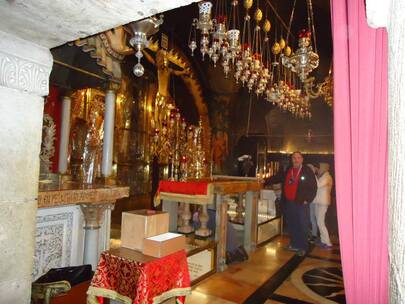|
Read: Matthew 27:33–28:10 (www.biblestudytools.com/nrs/Matthew/27.html)
Sing: Christ the Lord Is Risen Today, UMH 302 This is THE site for Christians. It is meaningful to see the places where Jesus was stripped of his garments (10); nailed to the cross (11); crucified (12); taken down from the cross (13); and laid in the tomb (14). But the main attraction in this church is the site of Jesus’ resurrection! (The Greek Orthodox name for this church is The Anastasis – The Church of the Resurrection.) The resurrection of our Lord Jesus Christ makes this place the most important place in the world for Christians. But that does not mean that the other things that happened here are unimportant. Each event had its own place in God’s plan to bring redemption to all of creation. The early Christians had already begun to venerate this site before the Bar Kochba Revolt in 132 AD. After the Romans had put down this second revolt in 60 years the emperor Hadrian was determined to put an end to Judaism and any sects of Judaism like Christianity. Hadrian had the major temple of his new Hellenistic city built on this site. Unwittingly, this helped mark this site and keep it well preserved. In 326 the emperor Constantine I had the pagan temple torn down and the hillside cut away from around Christ’s tomb. He then had a church built around these two sites (the crucifixion and resurrection). Constantine’s church was burned by the Persians in 614 and then rebuilt. That church was destroyed by the Muslims in 1009, including the destruction of the rock tomb, and then partially rebuilt. The Crusaders finished the reconstruction in 1149 and that is substantially the church we see today. This first visit I made to the Church of the Holy Sepulcher was rather frantic. The Sunday crowd was large and we were not given very long to see so very much. In my notes from that day I wrote, “I am not sure what I was looking at, but I know who died and rose for me!” I will get a second chance in just a few days.
0 Comments
Leave a Reply. |
AuthorIn matters of faith, we at First United Methodist Church, Sealy put primary reliance on the Bible. In scripture, we understand that we are all God’s children; therefore, we will be a church that cares for the needs of our church and local community through prayer, deeds, inspiration, and love in the spirit of Christ. Archives
July 2020
Categories |
Location |
Our MissionCaring for the needs of our church and community through prayer, deeds, inspiration and love in the Spirit of Christ.
Sunday Worship: 10 am Adult & Children & Youth Sunday School 9 am First Kids Mother's Day Out (Tuesday & Thursday; 8am to 2pm; Ages 1-3) Rev Pat Bell, Pastor First United Methodist Church Sealy
200 Atchison Street Sealy, Texas 77474 979.885.2223 |
Contact Us |

 RSS Feed
RSS Feed